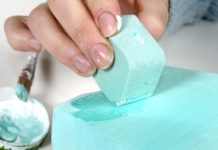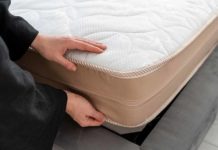
Not that long ago it was usual to “make a bed” with top and bottom sheets and blankets, and possibly with a quilt or comforter, and/or a bed cover over the top of the bedding to keep it looking neat and tidy during the day. Today it is more usual to simply use a bottom sheet and then to sleep under a duvet that is fitted with a removable cover that can be changed and washed regularly.
But how do these different bedding items differ from one another, specifically comforters versus duvets? And what do they have in common?
- A quilt is a padded covering for a bed, usually made from two layers of fabric with another soft layer in between.
- An eiderdown is a type of quilt that is stuffed specifically with eider (duck) feathers.
- A duvet is defined in dictionaries as “a type of quilt used in bed instead of a top sheet and blankets”.
- A comforter is essentially a type of quilt that gives “comfort”, and it is sometimes found in the form of a small quilt for babies and younger children. Today these are made commercially with industrial machines rather than by hand.
So it is correct to assume that they are similar in many ways, but each a little different from the rest.
Quilts and Quilting
Quilting is an ancient craft that is well established in North America and in other parts of the world.
It seems that the craft was already established in the 12th century in Europe. However the craft of quilting wasn’t used for bedding in those days, but rather to make a type of garment that was worn under the armor of Crusaders for warmth and additional protection. It might even have started earlier since there is an example of what is described as “a quilted linen carpet” in a Russian museum in Saint Petersburg.
There is a beautiful old quilt that was made sometime between 1360 and 1400 in Sicily, Italy that is thought to be one of the earliest quilts to have stood the test of time. Sections of it are on display in the Medieval and Renaissance section of the V&A Museum in London. Called the Tristan Quilt, it is made of linen that has been quilted and padded with cotton wadding and the intricate pictures it features (illustrating the legend of Tristan and Isolde in the Middle Ages) has been outlined in brown and white linen thread.
While this particular quilt is incredibly detailed, with pictures as well as patterns on all sections, the craft of quilting may be as simple as stitching the fabric and padding together to form regular patterns, in what is now considered to be a quilted effect. In the case of a patchwork quilt, scraps of fabric are sewn together and then quilted.
Simple appliquéd quilts were first made in Europe in the 15th century, providing an alternative to expensive embroidery on clothing and household furnishings, including bedcovers and quilts. Patchwork quilts originated in America at the turn of the 19th century when the pioneers trekked across the new country in search of farmland. This particular craft was born out of frugality as the women had few resources, and so used scraps of any fabric they could find, often from worn clothing.
The earliest patchwork quilts were called “crazy quilts” because they were made using irregular sizes and shapes of fabric. But as the craft developed, pieces used were more regular, and pattern books were published giving ideas of how to make patchwork blocks and how to quilt them.
While quilting is geometric, appliqué is pictorial. Another difference is that appliqué involves sewing pieces of fabric onto a background cloth instead of the patchwork blocks becoming the cloth that is sewn to the padding.
While both patchwork and appliqué were originally handcrafts, most people today use sewing machines for the stitching. But because this type of quilt isn’t mass-produced, it is still considered handwork.
Generally quilts are attractive and so normally used without a bedspread.
Eiderdowns and Comforters
While an eiderdown is, strictly speaking a quilt that is stuffed with the feathers (or down) of eider ducks, it was also the traditional name for quilts in general in the United Kingdom. Like all forms of quilt, eiderdowns are attractive bed covers that may be used decoratively, in place of a bed cover. They are also warm. Originally they were marketed as a lighter alternative to heavy wool blankets.
Over the years eider down (or feathers) has become very expensive, and so the trend has moved towards duvets instead, particularly those stuffed with polyester and other synthetic fillings.
It seems that like patchwork, the comforter originated in America – or rather that this is where the term was first used. Like eiderdowns, comforters are quilted, and are often used instead of a bed cover. They are mass produced and available in a huge number of designs. Some have reversible covers.
One of the biggest disadvantages of old-fashioned eiderdowns was that they couldn’t be washed, although dry cleaning is acceptable. Quilts and comforters stuffed with good quality synthetic fiber can be washed; be sure to follow the manufacturer’s instructions on the tag.
Duvets
It seems that duvets originated in Europe, which is why they are sometimes called continental quilts. Traditionally, in Scandinavia and countries like Austria and Switzerland, they were always filled with either goose or duck down. In fact villagers in these regions would save the down from their ducks and geese and then make duvets for young brides, as part of their dowry.
Sir Terence Conran, founder of the Habitat Stores which he launched in 1964 and sold to IKANO in 2009, is acknowledged with being the first to sell duvets in the UK. By the time his best selling The Bed and Bath Book was published in 1978, the popularity of duvets had spread to the UK, the USA and other Western countries, and today they are common all over the world.
“Sleeping under a duvet (alternatively called a continental quilt), a common practice in Scandinavian and mid-European countries, has spread widely in the UK and is growing in popularity in the USA,” he wrote. “Today’s duvets can replace all other forms of bed covering: they trap the body’s natural warmth with a layer of very light but bulky filling material sewn between two layers of specially woven cloth.”
Duvets come in a range of sizes to fit different sized beds, and are always larger than the bed itself. They also come with a variety of fillings, from traditional down, less expensive feathers, or a combination of down and feathers, to cheaper, usually non-allergic synthetics. They are lightly quilted to keep the filling reasonably evenly distributed. Like quilts and comforters, washability and cleaning methods depend on the filling and quality of the duvet, so always follow the care instructions on the product.
The main advantage of duvets is that you can use them with a range of covers which are removed and regularly washed. In addition to the cleaning advantage, you can change the look of your bedroom as frequently as you wish.
Duvets may be used with or without a top bed cover.
When you consider the pros and cons of comforters versus duvets, take both the decorative and ease-of-care factors into account.





